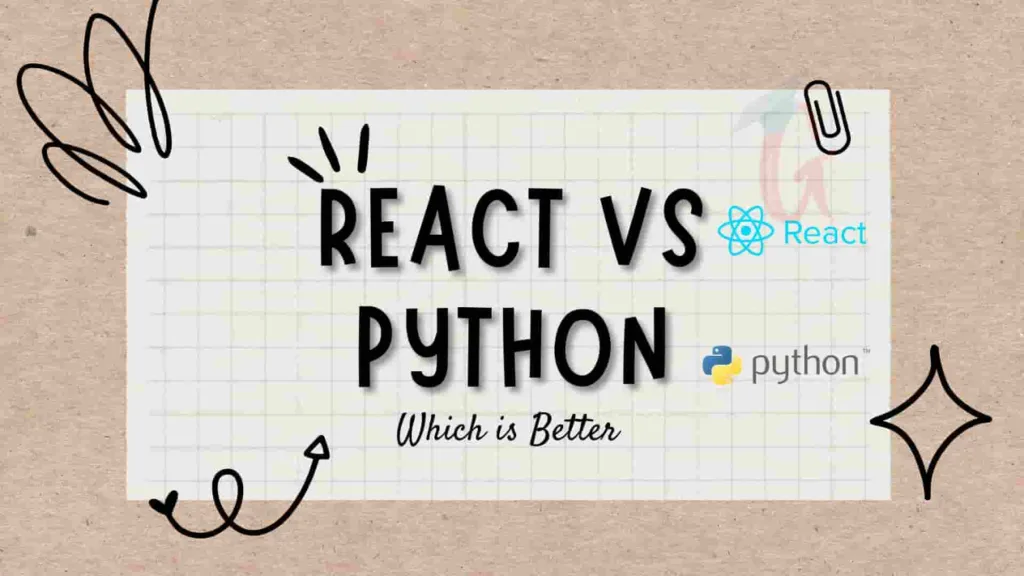React and Python are two widely used technologies that are often compared to each other in terms of ease of use. While they both serve different purposes, it’s natural to wonder which one is easier to learn and use. In this article, we will explore the differences between React and Python, and try to answer the question: is React easier than Python?

What is React?
User interfaces are made using the React JavaScript package. It was created by Facebook, and Facebook and a developer community are now maintaining it. Developers can easily create reusable UI components with React and construct sophisticated applications. Because it can be used to create desktop, mobile, and single-page applications, React is especially well-liked by web developers.
React’s simplicity is one of the factors contributing to its popularity among developers. The declarative syntax is used by React, which makes code easier to read and write. Additionally, it makes it possible for developers to construct intricate user interfaces (UIs) using smaller, reusable components, which saves time and requires less code.
React also has the benefit of integrating easily with other JavaScript libraries and frameworks. It is simple to integrate with other well-known libraries, such as Redux and React Router, enabling programmers to create even more potent applications.
What is Python?
The general-purpose programming language Python, on the other hand, is used for a wide range of applications. Guido van Rossum created one of the most well-liked programming languages currently in use in the latter half of the 1980s. Because it can be used for data analysis, machine learning, and other scientific applications, Python is especially well-liked among data scientists.
Python’s readability is one of the factors contributing to its popularity. Python’s syntax resembles that of natural language, which makes it simpler to read and write code. Additionally, it has a sizable standard library that makes it simple to locate and utilize pre-made functions and modules.
Python is renowned for its adaptability as well. It can be applied to desktop programs, scientific computing, web development, and other things. It is simple to find resources and support for Python because of the large community of developers who contribute to open-source projects and libraries.
Developers can create dynamic, data-driven websites using Django’s strong templating engine. On the other hand, React uses a virtual DOM rather than a templating engine to render UI components quickly.
Which is simpler, React or Python?
Both React and Python have benefits and drawbacks when it comes to usability. Which one is simpler to use and learn ultimately depends on your background and the particular project you’re working on.
React might be simpler to learn than Python if you have prior experience with web development and JavaScript. React is simple to comprehend and use due to its declarative syntax and modular approach to building user interfaces. Furthermore, React’s compatibility with other JavaScript libraries and frameworks allows you to build effective applications quickly and effectively.
However, Python might be simpler to learn if you’re new to programming or have no technical background. The large standard library of Python makes it simple to find and use pre-built functions and modules, and its syntax is simple to read and write. Additionally, due to Python’s adaptability, you can use it for a variety of applications, including scientific computing and web development.
In the end, how challenging it is to learn and use React or Python will vary depending on your background, level of experience, and the particular project you’re working on. Both technologies have advantages and disadvantages, so you should pick the one that best meets your requirements.
Advantages of React and Python
| React | Python |
|---|---|
| Easy to Learn: React’s syntax is easy to understand and use, particularly for developers who are already familiar with JavaScript. Its component-based architecture allows developers to create reusable UI components, reducing code complexity and making it easier to maintain. | Easy to Learn: Python’s syntax is easy to read and write, particularly for beginners who are just starting with programming. |
| Reusable Components: React’s component-based architecture makes it easy to reuse code and create modular, scalable applications. This means developers can focus on writing high-quality code rather than reinventing the wheel each time. | Python’s versatility makes it suitable for a wide range of tasks, including scientific computing and web development. |
| Declarative Syntax: React’s declarative syntax allows developers to write code that is easier to understand and maintain. This approach focuses on what code should do rather than how it should do it. | Large Standard Library: Python has a vast standard library, making it easy to find and use pre-built functions and modules. |
| Large Community: React has a sizable and active developer community, so individuals looking to learn more or advance their abilities may find a wealth of materials, tutorials, and tools online. | Readability: Python’s syntax resembles that of natural English, making the language more readable and easier to comprehend. |
| Seamless Integration: React can be easily integrated with other popular libraries and frameworks, such as Redux and React Router, allowing developers to build even more powerful applications. | Large Community: The Python programming language has a sizable and vibrant developer community that supports and helps others while also making contributions to open-source projects. |
Disadvantages of React and Python
| React | Python |
|---|---|
| Steep Learning Curve: Although React’s syntax is easy to learn for developers already familiar with JavaScript, it can be challenging for beginners who lack prior experience in the language. | Performance Issues: Python can be slower than other programming languages, particularly when handling large amounts of data or complex calculations. |
| Limited Functionality: React is primarily used for building user interfaces and is not suitable for applications that require complex back-end logic. | Limited Scalability: Python may not be suitable for building large-scale applications that require complex back-end logic. |
| Browser Compatibility: React may not work properly on older browsers, which can limit the audience for applications built with React. | GIL: Python’s Global Interpreter Lock (GIL) can limit its ability to perform multithreading, which can slow down performance in some cases. |
| Boilerplate Code: React requires a lot of boilerplate code, which can be time-consuming to write and maintain. | Dependencies: Python can have complex dependencies, which can be difficult to manage and update. |
| Performance Issues: React can be slower than other JavaScript libraries and frameworks, particularly when handling large amounts of data or complex UIs. | Debugging: Debugging Python code can be challenging, particularly for beginners, as Python’s dynamic nature can make it difficult to pinpoint errors. |
Read more about Python
Conclusion
Both Python and React are well-liked programming languages with a variety of uses. Even though it makes sense to contrast them in terms of usability, the solution is not simple. Python is simpler to learn and use if you’re new to programming or have no prior experience with computers or technology, while React is simpler to learn and use if you’ve worked with JavaScript and web development.
The decision between Python and React ultimately comes down to your unique requirements and the project you’re working on.



